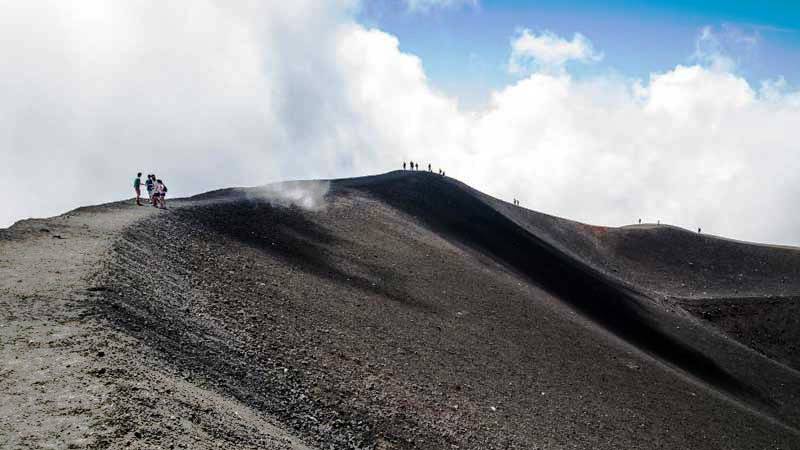ATTRACTIONS, ACTIVITIES AND TOURS
Mount Etna is the largest volcano in Europe with a summit of about 3,350 metres. It is widely known for its frequent eruptions; the most disastrous eruptions were those of 1669 and 1928. An observatory is located at the base of the central crater, at 2,942 metres. Vegetation follows the typical stratification patterns: a cultivated area up to 1,300-1,400 m, followed by a wooded area up to 2,000 m, with desert above that.
The excursion to Mount Etna is one of the main tourist attractions and is strongly recommended. The ascent to the volcano can begin from either the north or the south side. The two trails offer different views and features. The trail from Nicolosi to Rifugio Sapienza is more bleak, black and desert whilst the trail to Piano Provenzana is immersed in green. Each season has its own charm and interest: in the spring it is nice to see the blooms, the summer offers better weather, whilst the winter is attractive for those who enjoy cross-country skiing.
CASTELMOLA
In an elevated location, about 2.5 km (1.5 miles) from the centre of Taormina, stands Castelmola, a delightful village with just over a thousand residents. The origins of Castelmola date back to the pre-Hellenic period. The name is inspired by the shape of the large rock on which it stands, reminiscent of a wheel (in Italian, 'Mola'). This was once the location of Taormina's ancient citadel, perhaps due to its elevated position. Today, a well-preserved medieval castle stands on the spot.
The village is built on a medieval plan that has changed little over the centuries due to the sparse interest paid to the location until recent times. Today, Castelmola is a charming village that attracts many tourists. In the many quaint bars and restaurants, visitors can enjoy excellent Sicilian cuisine, fine local wine and the famous 'Vino alla Mandorla' ('Almond Wine'), a local speciality offered gratis to all visitors. There are a number of ancient monuments, such as the remains of a Norman castle, the village church, the churches dedicated to St. George and St. Blaise, and the Saracen door along the city walls.
SIRACUSA | SYRACUSE
The great and noble past of Syracuse is still clearly visible today in this dynamic city, nestled in one of the most beautiful bays in the Mediterranean. The chaotic urban sprawl of the modern part hasn't forced itself upon the cradle of Syracuse, Ortigia (the small island adjacent to the coast and the oldest urbanized part of the city): the charm of its Classical monuments and the splendour of its Baroque façades have not been affected.
Syracuse's fame is closley linked with its Greek history: from a time when the Greeks commanded the seas and, undermining the Carthaginians and the Romans, became the first great empire of the West. Many relics from that era remain, such as the Galermi acquaduct and the famous Arethusa Fountain, a source of fresh water in the heart of Ortygia, linked to the myth of Arethusa and Alpheus and celebrated by many poets and writers. The ancient centre of the city can be found in the Syracuse Archeological Park where the Greek Theatre, the Ear of Dionysius and, close by, the altar of Hiero II, are located.
The city was once defended by a wall and was dominated by the Castello Eurialo, the only surviving example of an unconquered and intact Greek fortress. In order to build it – and other contemporaneous Greek temples – several quarries were excavated, the most famous of which is the Latomia dei Cappuccini. Here, soldiers taken prisoner during the war with Athens were imprisoned and left to starve to death. Syracuse also has some partially intact temples, the most famous of which is the Temple of Apollo, the oldest in Sicily and located in Ortygia, and the Temple of Zeus, which is the second oldest temple in the city.
The Cathedral of Syracuse is none other than the beautiful Athenaion, built by Gelo after the victory of Himera. Inside, the history of Western religion can be traced: the central nave was built from the naos (the cella of the Greek temple), while the perimeter of the aisles is marked by massive Doric columns from the ancient peristasis.
THE ALCANTARA GORGE
The Alcantara River received its name from the Arabs who crossed it by a stone bridge at Calatabiano, (al-Qantarah in Arabic means 'the bridge'). The river flows from the Nebrodi Mountains and is fed by the Castiglione and Francavilla rivers and by a spring at the foot of Mount Etna, just above Randazzo. The gorges are up to 25 metres high and between 2 and 5 meters wide at different points. Contrary to popular belief, this natural canyon was not carved out by water over the course of thousands of years. The most likely hypothesis is linked to a seismic event, with a wobbling motion that literally split the hardened lava (from Etna) in two, allowing the river to creep inside. This is proven by the fact that the face of the walls is intact and jagged.
Close to the town of Francavilla di Sicilia, Fondaco Motta – in the territory of Motta Camastra – is the most impressive and famous of Alcantara's gorges. It is over 6 km (3.5 miles) long, the first 3 km of which can be explored by foot. The uniqueness of this gorge lies in the structure of its walls, created by a flow of basaltic lava (silicon-poor but rich in iron, magnesium and calcium). The lava cooled slowly, creating pentagonal and hexagonal prismatic shapes that mirror its molecular structure.
GIARDINI NAXOS
Located halfway between Catania and Messina (about twenty minutes by car or train), Giardini Naxos is within an hour's travelling distance Fontanarossa airport. Naxos, founded by Chalcis in 734 BC, was the first Greek colony in Sicily. Since the fifties Giardini, now known as Giardini Naxos, has made an extraordinary progression from a small fishing village to what is now one of Sicily's main tourist attractions.
Things to see: just a short distance from the enchanting bay, Naxos offers visitors glimpses from its past, such as the seventeenth century Spanish defensive bastions, surprisingly in keeping with their surroundings notwithstanding their purely military purpose; the Archaeological Park and attached Archaeological Museum, which house a number of artefacts discovered during various excavation digs; and the Museum of Natural History.
CATANIA
Catania is about 50 km (30 miles) from Taormina and is easily reached by public transport or car. Dominated by Mount Etna, Catania has much to offer visitors, starting in the Baroque city centre with the Elephant Fountain, the symbol of Catania, the Amenano Fountain (nicknamed 'acqua a lenzuolo' by the locals), and the Chierici and Pardo palaces. In the same square, you will find the Palazzo Senatorio (town hall), the cathedral dedicated to St. Agatha (built in the eleventh century by Ruggero I and rebuilt after the earthquake of 1963), the Palazzo Vescovile and Porta Uzeda.
Worth visiting is Castello Ursino, built in the thirteenth century, the Massimo Bellini theatre, and Palazzo Biscari (the most beautiful public building in the city), which houses a museum of archaeology. Don't miss a walk along Via Crociferi where, starting from the arch of San Benedetto, you will pass the abbeys of Badia Grande and Badia Piccola, the churches of St. Benedict and of St. Francis Borgia, and finally reach the Jesuit College. Along Via Vittorio Emanuele, you will find the Ancient Theatre, made from lava stone in Roman style but with Greek origin, and adjacent Odeon. Not far from this street, you will find the houses of Giovanni Verga and Vincenzo Bellini.
As well as the shops along Via Etna, you can see: Piazza Università, Palazzo Sangiuliano, the façade of the Collegiate Church, Palazzo San Demetrio, the Church of San Michele Arcangelo, Piazza Stesicoro built around the remains of a Roman amphitheatre and Villa Bellini, from where you can enjoy a beautiful view of the city. At the top end of Via Etna, with its entrance on Via Longo, you can enjoy the charming botanical gardens.
Villa Siciliana Taormina
Via Tommaso Fazzello, 37/Bis | 98039 Taormina ME | Tel. +39 379 141 9345 | e-mail info@villasiciliana.com
Codice CIR 19083097A300968
© 2024 · VILLA SICILIANA








